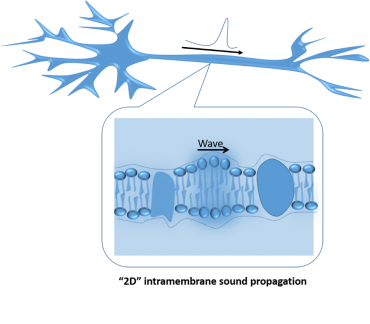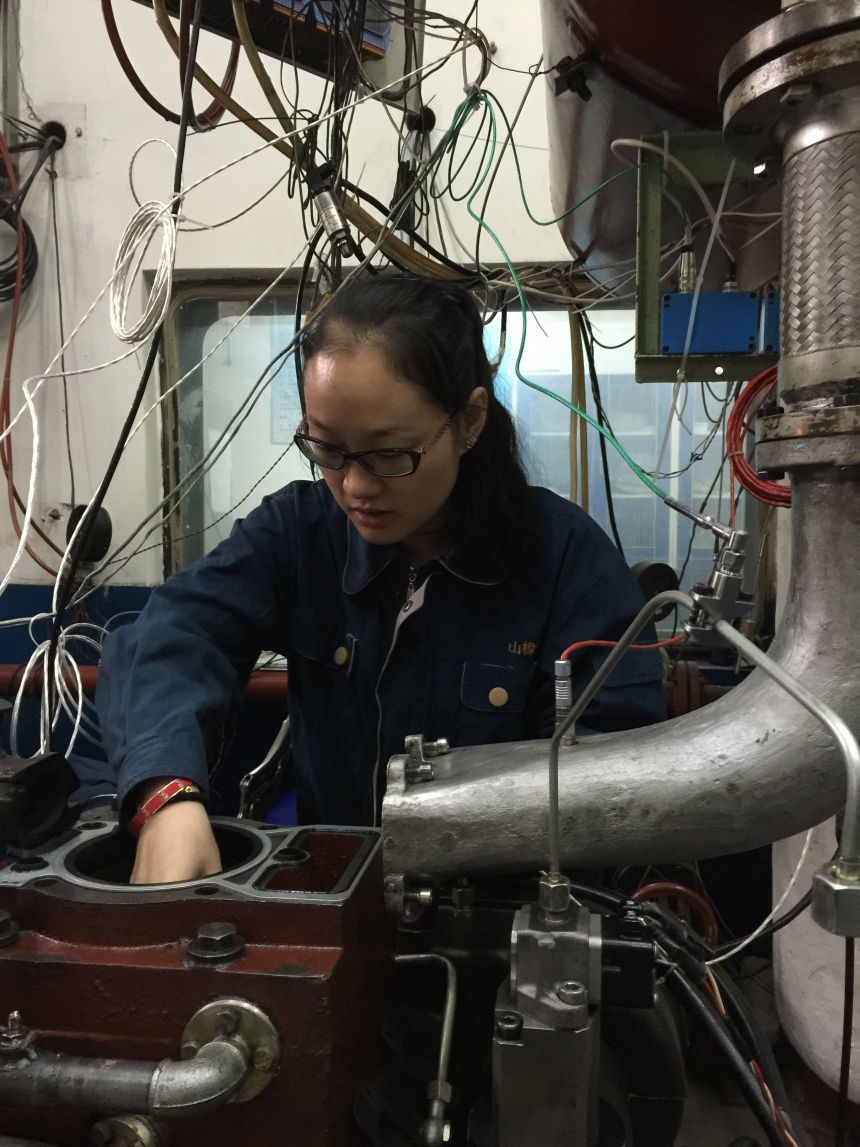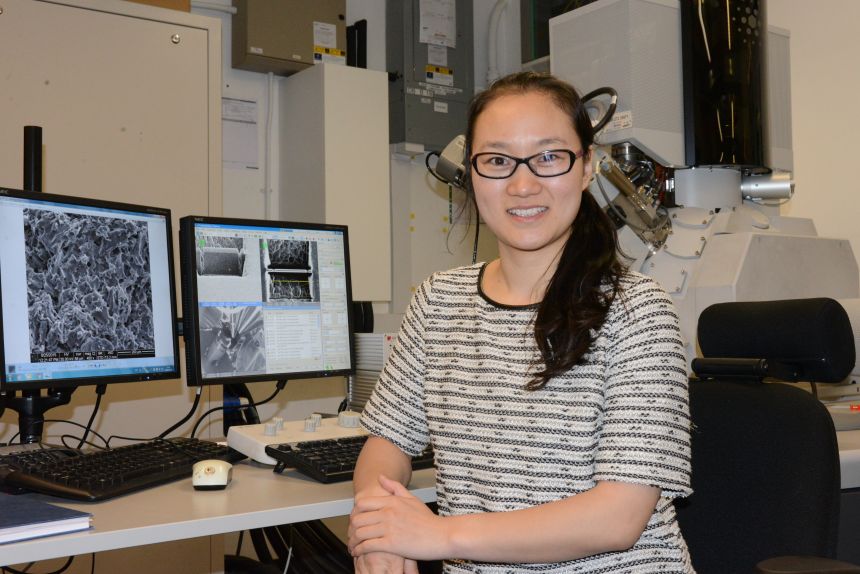Features
Shamit Shrivastava, a post-doctoral researcher in the Department of Engineering Science, writes about a recent finding that has far-reaching consequences for the fundamental understanding of the physics of the brain. The research was conducted in partnership with Professor Matthias F Schneider at the Technical University in Dortmund, Germany.
The findings, published in the Journal of Royal Society Interface, provide the experimental evidence that sound waves propagating in artificial lipid systems that mimic the neuron membrane can annihilate each other upon collision – a remarkable property of signals propagating in neurons that was considered to be inaccessible to an acoustic phenomenon.
Nerve impulses are believed to propagate in a manner similar to the conduction of current in an electrical cable. However, for as long as the electrical theory has been around, scientists have also been measuring various other physical signals that are equally characteristic of a nerve impulse, such as changes in the mechanical and optical properties that propagate in sync with the electrical signal. Furthermore, several studies have reported reversible temperature changes that accompany a nerve impulse, which is inconsistent with the electrical understanding from a thermodynamic standpoint.
To address these inconsistencies, researchers had previously proposed that nerve pulse propagation results from the same fundamental principles that cause the propagation of sound in a material and not the flow of ions or current. In this framework, the electromechanical nature of the nerve impulse, also known as an action potential, emerges naturally from the collective properties of the plasma membrane, in which the sound or the compression wave propagates. Thus the characteristics of the wave are derived from the principles of condensed matter physics and thermodynamics, unlike the emphasis on molecular biology in the electrical theory.
The suggestion has been highly controversial because of the well-accepted and widely successful nature of the electrical basis of nerve pulse propagation in spite of its few inconsistencies. As a wave phenomenon, nerve pulse propagation has remarkable properties, such as a threshold for excitation, non-dispersive (solitary) and all-or-none propagation, and annihilation of two pulses that undergo head-on collision. Moreover, sound waves are generally not associated with such characteristics, rather sound waves are known to spread out, disperse, dissipate, superimpose and interfere, which is counter-intuitive given the properties of nerve impulses.
Therefore, experimental evidence for such a phenomenon was crucial, which was provided by us in 2014. We showed that sound or compression waves can indeed propagate within a molecular thin film of lipid molecules, mimicking action potentials in the plasma membrane. Remarkably, even in such a minimalistic system that is devoid of any proteins and macromolecules other than lipids, these waves behave strikingly similar to nerve impulses in a neuron, including the solitary electromechanical pulse propagation, the velocity of propagation and all-or-none excitation. These characteristics were shown to be a consequence of the conformational change or a phase transition in the lipid molecules that accompany the sound wave. Thus only when sufficient energy is provided to cause a phase change in the lipids (fluid to gel-like), the entire pulse propagates otherwise nothing propagates, the so-called all-or-none propagation.
Now, in research published in the Journal of Royal Society Interface, we have shown that these waves can even annihilate each other upon collision, just like nerve impulses. Even from a purely acoustic physics perspective, this is a remarkable finding. The amplitudes of two sound pulses colliding head-on typically superimpose linearly before passing each other unaffected. Even nonlinear sound pulses, such as solitons, typically remain unaffected upon collision, which was a major criticism of the proposed acoustic theory of nerve pulse propagation.
With the observation of annihilation of colliding sound pulses in the model lipid system, we have shown that qualitative characteristics of the entire phenomena of nerve pulse propagation can be derived solely from the principles of condensed matter physics and thermodynamics without the need for molecular models or fit parameters of the electrical theory. We have demonstrated a unique acoustic phenomenon that combines all the observable characteristics that define the propagation of nerve impulses. This strongly suggests that the underlying physics of propagation of sound and nerve impulses is indeed one and the same.
 Sound waves propagating in artificial lipid systems that mimic the neuron membrane can annihilate each other upon collision.
Sound waves propagating in artificial lipid systems that mimic the neuron membrane can annihilate each other upon collision.Don’t be fooled by popular wisdom — when it comes to eating disorders, books can be just as harmful as other forms of media, finds Francesca Moll...
It is a truth seemingly universally acknowledged that the mainstream media can have a negative effect on eating disorders. But what about books? According to Dr Emily Troscianko, of Oxford’s Medieval and Modern Languages Faculty, we ignore them at our peril.
Dr Troscianko, whose research spans cognitive studies and German literature, also writes a blog for Psychology Today based on her personal experience with anorexia and the science of eating disorders. She was inspired to bring together the two sides of her research when she realised how little was known about the relationship between eating disorders and reading.
As part of a Knowledge Exchange Fellowship with TORCH (The Oxford Research Centre in the Humanities), she teamed up with BEAT, the UK’s largest eating disorders charity, to find out how these illnesses might affect how people engage with literature, and whether reading could help sufferers adopt more healthy ways of thinking.
Together they came up with a comprehensive survey of over 60 questions, assessing how mood, self-esteem, body image and diet and exercise habits were affected by reading. This was filled out by nearly 900 respondents in varying stages of eating disorder recovery, both from BEAT’s UK volunteer network and via sister charities in the US, Canada, and Australia.
The results proved quite a shock: certain books seemed to make illness worse, and these were the ones that the theory of ‘creative bibliotherapy’ predicts would be most helpful for recovery. It is generally assumed that illness narratives, where the main character goes through the same illness as the reader, would be best at generating insight and a desire to recover.
But Dr Troscianko found that in fact the reverse was true: an overwhelming majority of respondents reported decidedly negative effects on their illness from reading such fiction. Indeed, rather distressingly, it seems that many were aware of the negative effect on their mood that they caused, and sought them out deliberately with the intention of making themselves more ill.
Although these works rarely explicitly supported disordered eating, it seems that the moral was getting lost thanks to the restrictive thinking patterns of the readers. Sufferers ended up getting trapped in an endless ‘positive feedback loop’ where the unhealthy mindset that sent them there in the first place was reinforced by reading the same thing described on the page.
‘It’s clear that people are filtering out the stuff that doesn’t accord with the eating disorder mindset and just seeing the positives, the control, the sense of superiority, all those things that are covered in the early parts of the books before the recovery happens, and not seeing that there’s any critical angle on them,’ says Dr Troscianko.
Although it’s usually glossy magazines and TV shows that are blamed for encouraging disordered eating patterns, it’s clear books can be just as harmful, although in different ways.
‘I wonder whether in a way we’re kind of image-saturated. Skeletal catwalk models are still shocking and off-putting and fascinating to some extent, but I wonder whether encountering a description of such a person in words actually might do something equally problematic, just in a different way.
‘One of the things I get frustrated about is that people tend to assume because it’s literature it must be doing good. And there’s no reason to assume that.’
On the other hand, Dr Troscianko also found that many books had a helpful effect on eating disorders. These varied greatly depending on individual taste, with everything from Harry Potter to Pride and Prejudice being mentioned. What they had in common was that they helped to jolt the respondents out of their established thinking patterns by showing them that something else was possible outside of these confining boundaries, or else simply boosted their mood by providing a much-needed escape.
Rather than a narrow focus on the grim reality of eating disorders, then, therapeutic fiction may need to take a more oblique approach. Dr Troscianko is hopeful about the possibilities of metaphor, extended allegory, or even a science fiction or fantasy setting.
‘Eating disorders, all mental illnesses probably, are so much about getting stuck in very narrow circles of thinking and not being able to break out of them, that anything that breaks into that and just forces you to widen your gaze for a moment and to think differently, even just very temporarily, is powerful.’
Dr Troscianko is keen to emphasise that this survey is just the first step; she hopes to back up the subjective data of this self-reported survey with more in-depth psychological experiments.
‘The trouble is you do a little bit of research and then you find out how much you don’t know. But we’re getting there.’
You can read Dr Troscianko’s blog here, as well as following her latest projects — including developing an app to help eating disorder recovery. Visit the BEAT website here.
As MPs give Heathrow Airport's proposed third runway the green light, Professor David Banister, Emeritus Professor of Transport studies at Oxford University, sheds light on the issue of transport inequality and just why the proposed expansion has sparked such controversy.
London Heathrow (LHR) is the busiest airport in the UK with 48 million passengers beginning or ending their journeys in London, and an additional 28 million passengers making interconnecting flights to other destinations. The 3rd Runway will increase the total capacity to 130 million (+71%) and the number of flights will increase to 740,000 per annum (+56%). But who will be the new passengers flying from LHR?
About half the population of Great Britain has flown in the last year (47%), and this figure has been stable over the last 15 years. Most of those that do fly make one or two trips a year (31%). This means that 10% make about 60% of all flights, and as might be expected these people are mainly from the highest income groups. The richest 10% make 6.7 times as many trips by air as the poorest 10% of the population. The inequality in air travel in Great Britain is far higher than any other form of travel with the exception of High Speed Rail (10.3 times). Figures for the other forms of transport are much lower, with the difference for car travel being 2.75 times and for the bus the poor make more trips than the rich.
Some might argue that low cost airlines have helped rebalance this inequality, but the evidence would suggest that cheaper flights have enabled those already flying to travel more frequently and possibly to save money. Inequality is important as it reflects on societal values and the argument that society as a whole should gain. But it is equally important to identify who are the winners and who are the losers – it is about fairness and justice. This is particularly the case when large amounts of public money are involved. The new runway is estimated to cost £14 billion, with a similar amount being needed to improve road and rail links to the airport. A substantial part of this funding will come from Government and Transport for London.
It is likely that low income people will make only limited use of the new runway, but they will also be impacted by it indirectly through additional CO2 emissions. Overall, the richest 10% of households produced 3 times the levels of CO2 emissions than those from the poorest 10% of households, but for transport the difference is between 7-8 times and 10 times for aviation. New runway capacity at LHR will increase this difference, as more rich people fly further and more frequently. Local pollutants (e.g. NOx) and the noise impact are also likely to increase from the additional planes (and traffic). This means that it becomes much harder to meet CO2 reduction targets and improve local air quality, and air quality around LHR is already very poor.
Even the argument about the importance of increased airport to the local and national economies is weak. Business air travel accounts for about 20% of all passengers in Great Britain, with the figure for LHR being higher (30%). This market has been relatively stable, as the growth in air travel has come from leisure travel and visiting friends and relatives. In addition, UK residents are spending more overseas than others do coming to the UK. In 2016, there were 71 million overseas visits from UK residents and the total spend was £43.8 billion. There were 38 million visits to the UK and the total spend was £22.5 billion.
The clear conclusion is that on grounds of inequality, environment and spend, building additional airport capacity at LHR does not add up, as it will enable the richest 10% to fly even more and spend their money overseas. It will be the poorest 10% that stay in the UK, and they will suffer from even higher levels of CO2 emissions and poorer levels of air quality.
This analysis is based on National Travel Survey data (2002-2012) and Air Passenger Surveys carried out for the Civil Aviation Authority.
Read the full article on The Conversation here
This analysis of air travel in the UK forms part of Professor Banister’s new book Inequality in Transport, which will be published by Alexandrine Press on 12th July.
Tomorrow (27 June), Creative Multilingualism, a research programme funded by the AHRC and led by the University of Oxford, will hold a concert with 500 local primary school children to shine a spotlight on the many languages spoken in Oxford’s schools and communities. Programme leader Professor Katrin Kohl explains what motivated this celebration of Oxford’s multilingualism.
Oxford is a multilingual city. In 2017, one third of all students in Oxford city schools had a language other than English as their first language. One secondary school in East Oxford has speakers of over 100 different languages. The value of these additional languages is not always recognised, and sometimes home or community languages are even seen as a handicap to learning.
Yet research findings show the opposite. Studies such as those conducted by Multilingual Manchester have shown that making the most of languages children speak alongside English improves their academic progress overall. By nurturing their pupils’ multilingualism, schools can also take advantage of the many benefits linguistic diversity brings, from interpersonal skills and enhanced communicative competence to cultural intelligence and open-mindedness.
Creative Multilingualism is investigating how linguistic diversity – including different languages, dialects and registers – interacts with creativity. Our team of researchers in Modern Languages, Linguistics, English, Media Studies, Education, Anthropology and Biology are finding out how our ability to use more than one language enhances the creative repertoire of both individuals and groups in expressing identities and communicating with others.
With this concert, we want to encourage bilingual and multilingual pupils to share their languages and cultures with their friends and classmates. We Are Children of the World, a choral piece composed by Lin Marsh, will feature folk songs in seven different languages which are commonly found in Oxford’s schools: Mandarin, Punjabi, Urdu, Arabic, Polish, Swahili and Portuguese. The composition follows the sun’s journey as it travels from east to west, starting in China with a song about the fragrant jasmine flower and finishing with a samba in Brazil.
The concert has been organised in partnership with the Oxford Festival of the Arts. Jon Cullen, Director of Music at Magdalen College School, took on the challenging task of teaching the piece to 500 pupils in ten different schools, including participation of the County Youth Junior Choir. He produced PowerPoint slides for each part of the composition which include audio recordings and videos of him and composer Lin Marsh singing the piece line by line alongside the musical score. He also provided each school with backing track, score and lyrics. He visited the schools with a team of staff and A-level students from Magdalen College School, who helped the students master the words of the composition.
Last week, the schools came together for the first time to rehearse as a choir of 500, accompanied by an orchestra. A show of hands at the lunch break showed that we had speakers of all the languages which feature in the composition. The rehearsal was tremendously inspiring and the participants enjoyed exploring different cultures and parts of the world through song.
The concert on 27 June at the Sheldonian Theatre will be the first ever public performance of We Are Children of the World, but we don’t want it to be the last. After the concert, we will be making the composition including musical score, lyrics and teaching resources freely available on our website. We hope that schools across the country and beyond will use the composition as a springboard for conversations about languages and cultures from different countries – and for multilingual fun with singing.
Despite being one of the most fast evolving sciences in many ways, gender equality is one area where the field of engineering is playing catch-up. But, in spite of this continued imbalance, little by little, female engineers are shaping the world around us with their research achievements, developing scientific solutions to real world challenges.
In celebration of International Women in Engineering Day (June 23) – an initiative intended to raise the profile of women in engineering and physical sciences and encourage other budding scientists to join them, we wanted to shine a light on a female academic engineering a difference at Oxford.
Dr. Dong Liu is an independent research fellow at Oxford’s Department of Materials and a Soapbox Science ambassador. Specialising in materials sciences, physical sciences and mechanical engineering, Dr Liu’s research is focused on better understanding of new materials for nuclear reactors and how this can drive further developments in nuclear energy production.
For those that are not familiar, what is Materials Science – and how does it differ from Engineering in general?
To make any effective device, structure or product, you need the right material(s). Materials Science is the study of all materials – from the things you use every day like plastics, glass and sports and health care equipment, to more industrial appliances in aircrafts, space shuttles and nuclear reactors.
I am interested in how materials react to extreme conditions, for example, inside a jet engine or a reactor core, where heat and irradiation is a problem. Understanding how and why the materials degrade and break is key to designing and making stronger materials. Compared with Engineering, Materials Science focuses more on the mechanisms of the material failure. By gaining this knowledge, we can understand their engineering behaviour better.
By understanding a material’s strengths and weaknesses we can optimise its use and eventually make our nuclear energy sources more efficient and effective.
Which material does your research focus on?
My primary research interest is on ceramic-like materials used in aero-engines, e.g. ceramic coatings on turbine blades protecting them from the heat of the engine, and a material called graphite used in the core of nuclear reactors at power plants in the UK and some other countries.
What is graphite?
Nuclear grade graphite is used as the core of all 14 operating reactors that provide about 20% of the total electricity in the UK. It is much purer than materials used day to day, such as lead in pencils, so it’s ideal for building the core of nuclear reactors - a lesser material would interfere with the reactions.
 Dr Liu hard at work in the lab.
Dr Liu hard at work in the lab.What does your research involve?
Once installed, the graphite core cannot be taken out or replaced, so if it becomes unstable or develops cracks, we have to shut down the reactor. I study these cracks and work to understand why stability issues occur in general. By understanding a material’s strengths and weaknesses we can optimise its use and eventually make our nuclear energy sources more efficient and effective.
Working together with my colleagues at Lawrence Berkeley National Laboratory in California, we heated our nuclear graphite to more than 1000°C to test the tolerance of the material. We found that the material actually becomes stronger in high temperature environments and was less likely to fracture when heated up.
What impact has this research achievement had on your career?
Publishing our paper in Advance Science has boosted my reputation in the nuclear graphite research community and allowed me more international research opportunities.
The material is used in nuclear reactors in many other countries, including Europe, USA and China, where they are working to build the next generation of reactors, which are more powerful and environmentally friendly than previous models. I am supporting this work, analysing different grades of graphite material so that we can understand and use their tolerance levels to create a superior nuclear reactor that enables clean energy.
 Dr. Dong Liu is an independent research fellow at Oxford’s Department of Materials, her research focuses on testing and better understanding materials used in nuclear reactor cores to make our energy sources more effective and sustainable.
Dr. Dong Liu is an independent research fellow at Oxford’s Department of Materials, her research focuses on testing and better understanding materials used in nuclear reactor cores to make our energy sources more effective and sustainable.How did you come to specialise in this area?
I am excited by research that has an industrial imperative, it makes me feel that I am solving a real problem that is related to everyday life and helps our society.
Some people assume that research is dull, but scientific engineering is all about getting your hands dirty. Taking things apart and blasting them with boiling hot X-rays is all in a day’s work for me, and I love it.
What drew you towards a career in science?
Education is very important in China and my parents played an important role in my passion for academia. Even at primary school my mum said to me; ‘you have to get a Doctorate degree when you are older’, so I have always had that goal.
I’ve always believed that a burning desire to learn is the most powerful driving force in life. When I look at where I am now, I know that I have made the right decisions.
What has surprised you most in your career?
I used to think that working in science would be lonely and I would be stuck in a lab on my own 24/7. But, communication is a big part of the job, and collaboration is key to overcoming challenges.
Some people assume that research is dull, but scientific engineering is all about getting your hands dirty. Taking things apart and blasting them with boiling hot X-rays is all in a day’s work for me, and I love it!
What advice would you give to anyone beginning or considering a career in academic science?
Be brave, take as many opportunities as you can and keep an open mind. Being a scientist is about more than publishing papers and experiments. You are part of a community that has a responsibility for influencing people’s science perceptions and understanding.
I am involved in the Nuclear Institute’s Woman in Nuclear (WiN) initiative and in organising Oxford Soapbox Science events - the national initiative to make science more accessible to the general public and raise the profile of female scientists.
Another tip is to be aware of independent research opportunities – such as funded research fellowships. I have had two while at Oxford: 1851 Royal Commission Research Fellow (Brunel) and another with the Engineering and Physical Sciences Research Council (EPSRC).
Fellowships have been key to my career, and helped me to grow as an independent young academic. You are the leader, the worker and the negotiator for your own research – effectively you ‘run the show.’ Applications can be competitive and time consuming, but the pay-off is worth it.
How has your experience as a women in engineering shaped your career?
For me, being a young woman in Engineering has shaped my career. It is great to be young, but in academia youth isn’t always a good thing. People often assume that you must be older to practice good science, or to have a senior position. Male or female, being or looking younger can lead to your work being challenged, so you need to really know your stuff and prove yourself
From a positive perspective being challenged only makes you get better at what you do. Before I came to Oxford as an independent researcher, if someone had asked me if I was ready for a permanent position I would have panicked. But, my experience has improved my confidence in my teaching.
 Dr Liu is one of the core organisers for the Oxford branch of Soapbox Science - the national initiative to make science more accessible to the general public and raise the profile of female scientists.
Dr Liu is one of the core organisers for the Oxford branch of Soapbox Science - the national initiative to make science more accessible to the general public and raise the profile of female scientists.What do you think are the barriers to entry for women in STEM?
Stereotypes are a big issue. A student of mine once told me that her mother has a doctorate degree, but people always assume that the Doctor in her family must be her father.
Statistically less women are applying for jobs in science and engineering compared to men, which is why it’s so important to mentor young people to encourage them to take a science / engineering career.
I believe that everyone is equal and can make important contributions to science. A diverse workforce is needed to represent the multiple facets of knowledge, perspectives and values required to uncover the most significant findings.
How do you balance the stresses of work and home life?
Any work - science or otherwise, is like a marathon rather than a sprint. My philosophy is work hard play hard and I do lots of sports like kickboxing and hiking with friends in the sunshine.
What is next for you?
I am coming to the end of my Fellowships and will soon start a permanent Lectureship position with the School of Physics at Bristol University.
I feel really lucky to have been able to stay in academic science as long as I have and I feel it is my duty to raise awareness of women working in the sciences, sharing our cool research and letting others know that they can do this too.
What will you miss most about Oxford?
There is so much I will miss, but especially the people that I work with in the Materials Department - they are like extended family. I have lots of collaborative research coming up, so I will continue to be a visiting academic at Oxford.
I’ll miss the delicious, formal Mansfield College dinners, which are out of this world and great for networking - you never know who you are going to meet at the table. I recently met Professor Katherine Blundell who specialises in Astrophysics. She is so inspiring person and good at explaining complex science, she makes me think about how I can better communicate my own work.
View Dr Liu's paper 'Damage tolerance of nuclear graphite at elevated temperatures' here
- ‹ previous
- 65 of 247
- next ›





 World Malaria Day 2024: an interview with Professor Philippe Guerin
World Malaria Day 2024: an interview with Professor Philippe Guerin From health policies to clinical practice, research on mental and brain health influences many areas of public life
From health policies to clinical practice, research on mental and brain health influences many areas of public life From research to action: How the Young Lives project is helping to protect girls from child marriage
From research to action: How the Young Lives project is helping to protect girls from child marriage  Can we truly align AI with human values? - Q&A with Brian Christian
Can we truly align AI with human values? - Q&A with Brian Christian  Entering the quantum era
Entering the quantum era Can AI be a force for inclusion?
Can AI be a force for inclusion? AI, automation in the home and its impact on women
AI, automation in the home and its impact on women Inside an Oxford tutorial at the Museum of Natural History
Inside an Oxford tutorial at the Museum of Natural History  Oxford spinout Brainomix is revolutionising stroke care through AI
Oxford spinout Brainomix is revolutionising stroke care through AI Oxford’s first Astrophoria Foundation Year students share their experiences
Oxford’s first Astrophoria Foundation Year students share their experiences